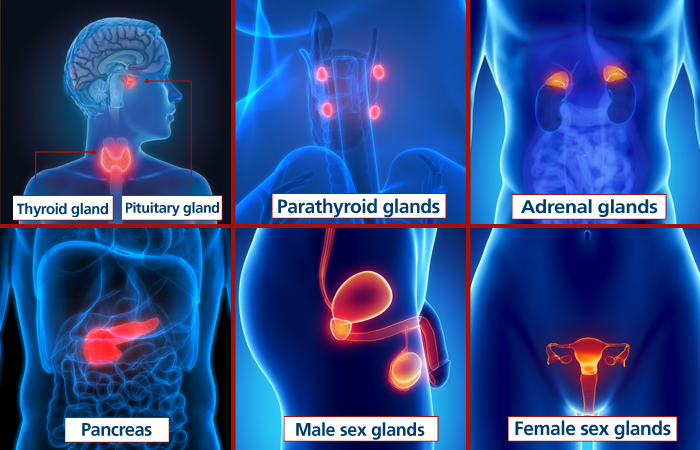
The thyroid gland
The thyroid gland is located in the neck and produces several important hormones:
- Thyroxine (T4) and triiodothyronine (T3) are produced in a ratio of approximately 80:20 and are important for growth, metabolism, maintenance of body heat and energy levels
- Calcitonin helps to maintain steady levels of calcium in the body. The mineral is continuously released from bones into the bloodstream so it can be redeposited in the bones to keep them strong. If calcium levels in the bloodstream pass a certain threshold, calcitonin is released, preventing the bones from releasing any more of the mineral and stopping the kidneys from reabsorbing it, which means more goes back into the bones and is excreted via the urine.
The parathyroid glands
The four parathyroid glands are each about the size of a grain of rice and are situated behind the thyroid. They secrete parathyroid hormone (PTH), which has the opposite effect to calcitonin in that it causes bones to release calcium into the bloodstream if not enough is being absorbed by the intestines and reabsorbed by the kidneys. Calcitonin and PTH work together – albeit in opposition – to keep blood calcium levels stable.
The adrenal glands
The two adrenal glands are located just above the kidneys, one on each side of the body. Each has an inner section called the adrenal medulla, surrounded by the adrenal cortex. The adrenal medulla secretes adrenaline and noradrenaline in the ratio 80:20. This happens very quickly due to it being controlled by the sympathetic nervous system – because hormones are chemicals that move via the bloodstream, the endocrine system is usually much slower to respond than the nervous system, which communicates via electrical impulses, and so triggers the fight/flight/freeze reaction. This prepares the body to deal with imminent danger, for example by causing heart rate to increase, pupils to dilate, and circulation to the GI tract and skin to drop so more blood can flow to the muscles and brain where the blood is urgently needed. The adrenal cortex produces three types of hormones:
- Glucocorticoids are sometimes known as stress hormones and include cortisol and cortisone. They are released in response to rising levels of ACTH from the pituitary gland, and have several actions, including increasing blood glucose levels, and suppression of the immune system and inflammatory and allergy pathways
- Mineralocorticoids, of which the main one is aldosterone, increase the reabsorption of sodium and water and the excretion of potassium in the kidneys, which cause blood volume and hence blood pressure to rise. Aldosterone release is controlled by renin, which is made by the kidneys
- The sex hormones testosterone, oestrogen and progesterone are all secreted by males and females but at different levels. Up until puberty, the adrenal glands are the only sources of sex hormones, but then the testes start producing testosterone in men and the ovaries oestrogen and progesterone in women.
Practice point: Collectively, glucocorticoids and mineralocorticoids are known as corticosteroids and there are many synthetic versions that are used for their anti-inflammatory effects. Can you match types of corticosteroids with the conditions they treat.
The pancreas
The pancreas is situated deep inside the abdomen behind the stomach. The two main hormones it produces are insulin and glucagon, which regulate blood glucose levels. The pancreas is sometimes referred to as a dual gland because it has both endocrine and exocrine functions: hormones secreted into the bloodstream to regulate blood glucose levels, and digestive enzymes that flow via the pancreatic duct into the gastrointestinal tract.
The sex glands
The gonads is the collective term for the sex glands:
- In females, the ovaries – one located on each side of the body just inside the pelvis – produce oestrogen and progesterone, the hormones that influence puberty, the menstrual cycle and pregnancy, among other things
- In males, the testes are situated in the scrotum – a pouch of skin that hangs just below the abdomen. They produce testosterone, which has several functions including the development of secondary sex characteristics during puberty, and sperm development. The reproductive system will be covered in more detail in the genitourinary Body Talk module.
